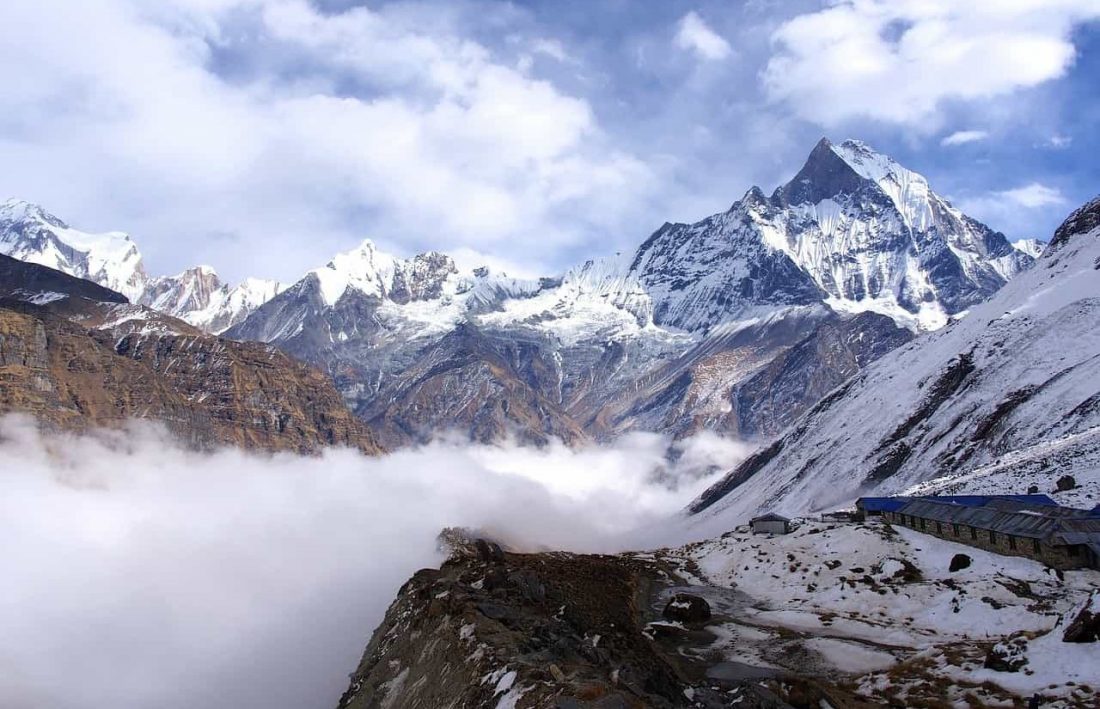Good deals for business flights to Nepal are rare. However, Star Alliance members Air India is currently offering relatively inexpensive tickets with departure from Amsterdam. You can get the round-trip journey from €1,381 (when booking through third-party providers). Departures are available between December 2025 to June 2026
Our availability calendar highlights all possible flight dates at the lowest price for trips up to 28 days. It will forward you to Skyscanner with your selected flight dates. You can also check what online travel agencies have to offer, as they sell these tickets up to €100 cheaper than the airline.

Subscribe to our WhatsApp Channel or Telegram Channel to get instant notifications for all of our best deals!
Boeing 787 planes are used for long-haul flights – these feature lie-flat seats in a 2-2-2 pattern in business class. On the short flight between Delhi and Kathmandu, you will fly in an Airbus A319 or Airbus A320 aircraft, with cushiony recliner seats in a 2-2 pattern.
Most EU citizens need a visa to enter Nepal. You can apply for it at a Nepalese consulate near you.
If you arrive at Kathmandu airport (KTM), you can also apply for visa-on-arrival. Filling out the form online prior to arrival is possible. You need to pay for the visa onsite, in cash.
European citizens require a tourist visa if they want to visit India. You can apply for it online at the official website. If you plan on continuing your journey on a separate ticket, you still need to apply for a tourist or transit visa.
Search & Book
Departures are available between December 2025 to June 2026. There is no minimum stay requirement.
You can find available dates very easily using Google Flights (Instructions), though the preview can be unreliable at times. You can book the flights through our Skyscanner or directly through Air India.
Why is booking with an airline better than with an online travel agency?
More often than not, online travel agencies offer lower fares than airlines do. We still recommend booking with the airlines directly. There are two main reasons for that:
Better Customer Service
In case any problems like delays, cancellations or missed connections arise, you can communicate directly with the airline. The airline has to take care of you because you have a contract with them.
If a travel agency issues your ticket, you may have to reach out to them first. You also depend on your OTA to forward information like flight changes instead of receiving them directly from the airline. In many cases, you may get a prime exhibition of responsibility shifting rather than problem-solving.
This especially applies to premium tickets. You don’t want to spend more than €1,000 to wind up with some budget OTA’s telephone hotline in case anything goes wrong.
Baggage and Other Fees
Economy fares not including hold luggage are industry standard by now. In most cases, travel agencies charge much higher baggage fees than the airlines themselves. If bags are not included in your fare, airlines are often the cheaper alternative.
This also applies to other things like food services, insurances or priority treatment. In almost all cases, you pay less for additional amenities when booking on the airlines’ website.
Editor’s Note: If you want to fly to Nepal while taking advantage of the benefits of business class, this is a good deal. In the end, you will only spend two hours in a recliner seat, but on the intercontinental flights, you will be in a lie-flat seat. It’s true that Turkish and Qatar offer options with all lie-flat seats, but they are thousands of euros more expensive.
Miles & Points
The booking class is Z, which leads to the following mileage credits:
- 21,538 Miles on Air China PhoenixMiles
- 17,844 Miles on Aegean Miles+Bonus
- 17,844 Miles on Ethiopian ShebaMiles
- 17,844 Miles on TAP Miles&Go
- 13,384 Miles on Turkish Airlines Miles&Smiles
- 13,384 Award Miles + 480 Points on Miles&More
- 11,154 Miles on Asiana Club
- 11,154 Miles on Air Canada Aeroplan
- 11,154 Miles on EVA Infinity MileageLands
- 11,154 Miles on Copa ConnectMiles
- 11,154 Miles on Singapore KrisFlyer
- 11,154 Miles on Thai Royal Orchid Plus
- 11,154 Award Miles + 5,576 Tier Miles on Avianca LifeMiles
- 11,154 Miles on ANA Mileage Club
- 11,154 Points + 2,232 SQC on Air Canada Aeroplan 2026
- 8,922 Award Miles + 1,490 PQP on United MileagePlus
- 8,922 Miles on Egyptair Plus
- Customize Calculation
Destination
Information & Tips for Nepal
Nepal, located between India and China, is known for its dramatic mountain landscapes and cultural heritage. The main tourist sights include Kathmandu’s historic temples, the lakeside town of Pokhara, and trekking routes in the Annapurna and Everest regions. The local currency is the Nepalese rupee (NPR), and prices are generally low compared to Western standards, though costs rise in remote trekking areas. The weather varies by altitude—Kathmandu has a mild climate, while mountain regions can be cold year-round. The best travel seasons are spring (March–May) and autumn (September–November), when skies are clearest.
Nepal’s transport infrastructure is limited, and getting around can be slow. Within cities like Kathmandu, traffic congestion and poor road conditions are common, with taxis, buses, and motorbikes being the main options. Public transport is cheap but often crowded and irregular. Travel between cities is usually by bus or private vehicle, as the railway network is minimal and domestic flights, while faster, can be affected by weather and limited schedules. Road journeys often take longer than expected due to narrow, winding routes and frequent maintenance delays.
→ All Dealz for Nepal
Information & Tips for Delhi
Delhi, India’s capital, is known for historic sites like the Red Fort, Humayun’s Tomb, and Qutub Minar, as well as vibrant markets and cultural districts. The local currency is the Indian rupee (INR), and cash is widely used, though cards and digital payments are increasingly common. Prices are generally low by international standards, making it a budget-friendly destination. The weather is extreme—very hot in summer (April–June), with a monsoon season from July to September, and cooler, more comfortable weather from October to March.
→ All Dealz for Delhi
Cover Picture: © chiaoyinanita - Pixabay.com License

